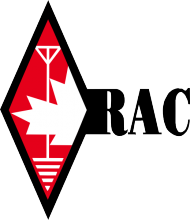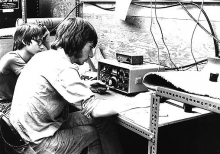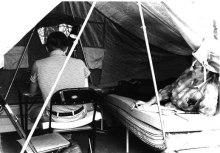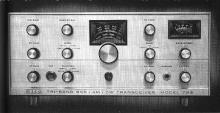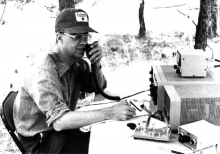Main menu
You are here
My First Field Day
by Ken Hoshowski, VE7FP
CQ Field Day, CQ Field Day de VE7………
My interest in radio began when I was about 12 years old and I acquired a tube-type AM radio and installed a long wire antenna which was great for listening to American radio stations at bedtime. When I should have been asleep, I remember my Dad hollering from his bedroom to turn off that radio and go to sleep. I was determined to get a Ham license and when I was 16, I thought I was ready to write the exams and went to Kelowna for the test. Unfortunately, the radio inspector had been called away unexpectedly and I was unable take the test. I came home very disappointed and I instead pursued getting a driver’s license and probably girls!?
Moving ahead 9 years, now married and living in Powell River I saw a car in the parking lot where I worked with the call plate “VE7DO”. I approached the owner and struck up a conversation which led to a long friendship. Art Muskett, VE7DO was instrumental in helping me get my license, and I was finally licensed in November 1966 and soon after became a member of the Powell River Amateur Radio Club. There was much talk about the upcoming Amateur Radio Field Day and although I had no idea what they were talking about, I was put on the planning committee. Because I was the manager of the local Super Valu grocery store, I was put in charge of feeding the crew, purchasing the groceries (big discount), and managing the kitchen.
I soon found out that a Field Day was an emergency exercise testing our preparedness and skills in setting up a radio station(s) under adverse and emergency conditions. A good example was a few years previously in March of 1964 when Alaska had a huge earthquake near Anchorage. The local ham community were instrumental in providing communications between Alaska and the lower 48 states. Remember this was before computers, emails, and internet so amateur radio played a huge part in local and long-distance communications.Field Day is sponsored by the ARRL (American Radio Relay League) and is held the last week in June annually. It is an international competition with amateurs participating either individually or as groups or clubs throughout the world. The competition is for a continuous 24-hour period.
Our Club found a beautiful site about 4000 feet in elevation on a mountain side about 10 miles NW of Powell River. We were fortunate to have a warm and sunny weekend. We had a wonderful view overlooking Harwood and Texada Islands and down the Malaspina Strait in the direction of Nanaimo.
The group packed up on Friday evening all the gear required to set up three stations, antennas, generators, tents, tower and associated equipment. My station wagon was full of groceries, coolers, ice, and grills for the kitchen.
We left town early Saturday morning so that we could be set up by the official starting time of noon.
Our plan was to have three operating tents about 100 feet apart, and each tent would house one complete station for 80, 40, and 20 meters. Antennas for 80 and 40 meters would be dipoles and we used a beam for 20 meters. The dipole antennas were strung up using a bow and arrow and a fishing rod. The fishing line was taped to the arrow and fired high over tree branches and then a rope was attached to pull the antennas up. The 20 meter beam was on a 20-foot guyed tower. We had shifts set up for an operator and logger at each tent. Because we were operating under full emergency (using generators) we received a multiplier when calculating our score. There are different criteria for scoring regarding number of stations operating, power sources, etc. We also had a 2 meter single channel converted taxi transceiver on 147.330 MHz.At 12 noon we were on the air, the 20 and 40 meter stations were operating on CW, and the 80 meter station was operating on my newly constructed triband EICO 753 SSB transceiver.
We had three excellent CW operators, Art Muskett VE7DO, Bob Gela VE7BOQ, and Vince Chapman, VE7ALZ. All were in the 40 wpm range. Back then, before computers, email, and internet, all logging was done manually. The logger’s job was to record each contact and make sure we did not record duplicate contacts, which was especially difficult when you had a couple hundred contacts over 24 hours on each band with different operators and loggers. Many times, you would hear “OOPS, we already have you”. It is permissible to count a station three times as long as it was on three separate bands. As mentioned earlier we had great weather and it gets quite hot in a tent with tube type equipment adding to the heat. I happened to walk into one tent about 5 pm only to find Bob Gela sitting in his underwear with sweat rolling off his face. About midnight the 20 meter band went dead until early morning when we were able to resume that station.Our crew of about a dozen members needed to be fed and we had set up table, chairs, grills and of course a 24-hour coffee pot. Sandwiches for lunch, steak and fried potatoes for dinner, and bacon and eggs for breakfast.
A well-fed crew is a happy crew, and a happy crew we were, with the usual kidding and good-natured teasing. We all had a good time and as I recall we placed third in total points for the British Columbia section. For me, this being my first Field Day was the most memorable of many I have attended. The second most memorable was when I had moved to Salmon Arm and we set us stations at Anstey Arm on Shuswap Lake with one station on a houseboat.
If you have never participated in a Field Day before please add this to your bucket list for the next post-pandemic Field Day. You will find it a fun experience.


